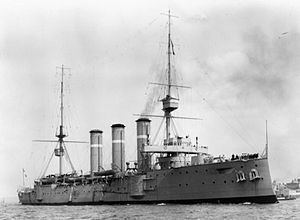Laid down 19 February 1901 Decommissioned Paid off, April 1920 Launched 16 December 1902 Draft 7.6 m | Namesake Cumberland Completed 1 December 1904 Construction started 19 February 1901 Length 141 m | |
 | ||
Fate Sold for scrap, 9 May 1921 Builders London and Glasgow Shipbuilding Company, Govan | ||
HMS Cumberland was one of 10 Monmouth-class armoured cruisers built for the Royal Navy in the first decade of the 20th century. She was assigned to the 2nd Cruiser Squadron of the Channel Fleet upon completion in 1903. After a refit in 1907–08 she became a training ship in the Home Fleet. She was sent to West Africa after the beginning of World War I in August 1914 and captured 10 German merchant ships in September. Cumberland spent the rest of the war on convoy escort duties and patrolling for German commerce raiders. She was sold for scrap in 1921 and broken up two years later.
Contents
Design and description
Cumberland was designed to displace 9,800 long tons (10,000 t). The ship had an overall length of 463 feet 6 inches (141.3 m), a beam of 66 feet (20.1 m) and a deep draught of 25 feet (7.6 m). She was powered by two 4-cylinder triple-expansion steam engines, each driving one shaft, which produced a total of 22,000 indicated horsepower (16,000 kW) and gave a maximum speed of 23 knots (43 km/h; 26 mph). The engines were powered by 31 Belleville boilers. She carried a maximum of 1,600 long tons (1,600 t) of coal and her complement consisted of 678 officers and enlisted men.
Her main armament consisted of fourteen breech-loading (BL) 6-inch Mk VII guns. Four of these guns were mounted in two twin-gun turrets, one each fore and aft of the superstructure and the others positioned in casemates amidships. Six of these were mounted on the main deck and were only usable in calm weather. They had a maximum range of approximately 12,200 yards (11,200 m) with their 100-pound (45 kg) shells. Ten quick-firing (QF) 12-pounder 12 cwt guns were fitted for defence against torpedo boats. Cumberland also carried three 3-pounder Hotchkiss guns and two submerged 18-inch torpedo tubes.
Beginning in 1915, the main deck six-inch guns of the Monmouth-class ships were moved to the upper deck and given gun shields. Their casemates were plated over to improve seakeeping. The twelve-pounder guns displaced by the transfer were repositioned elsewhere. At some point in the war, a pair of three-pounder anti-aircraft guns were installed on the upper deck.
The ship's waterline armour belt had a maximum thickness of four inches (102 mm) and was closed off by five-inch (127 mm) transverse bulkheads. The armour of the gun turrets and their barbettes was four inches thick while the casemate armour was five inches thick. The protective deck armour ranged in thickness from .75–2 inches (19–51 mm) and the conning tower was protected by ten inches (254 mm) of armour.
Construction and service
Cumberland, named for the English county, was laid down by London and Glasgow Shipbuilding at their shipyard in Govan on 19 February 1901 and launched on 16 December 1902. She was completed on 1 December 1904 and assigned to the 2nd Cruiser Squadron of the Channel Fleet. She was transferred to the Home Fleet in December 1906 and was refitted to serve as a cadet training ship from 1907–08. From May 1912 to July 1914 she was under the command of Captain Aubrey Smith and was present for the July 1914 Fleet review at Spithead.
She was sent to West Africa after the beginning of the war in August and supported operations in the Cameroons where she captured 10 German merchantmen at Douala on 27 September. She was assigned to the 5th Cruiser Squadron in January 1915 where she conducted patrols for German raiders and escorted convoys for the rest of the war.
Decommissioning and disposal
Cumberland was paid off in April 1920 in Queenstown, Ireland and sold to Thos W Ward for scrap on 9 May 1921. She was finally broken up at Briton Ferry in 1923.
